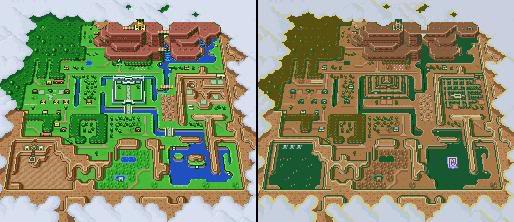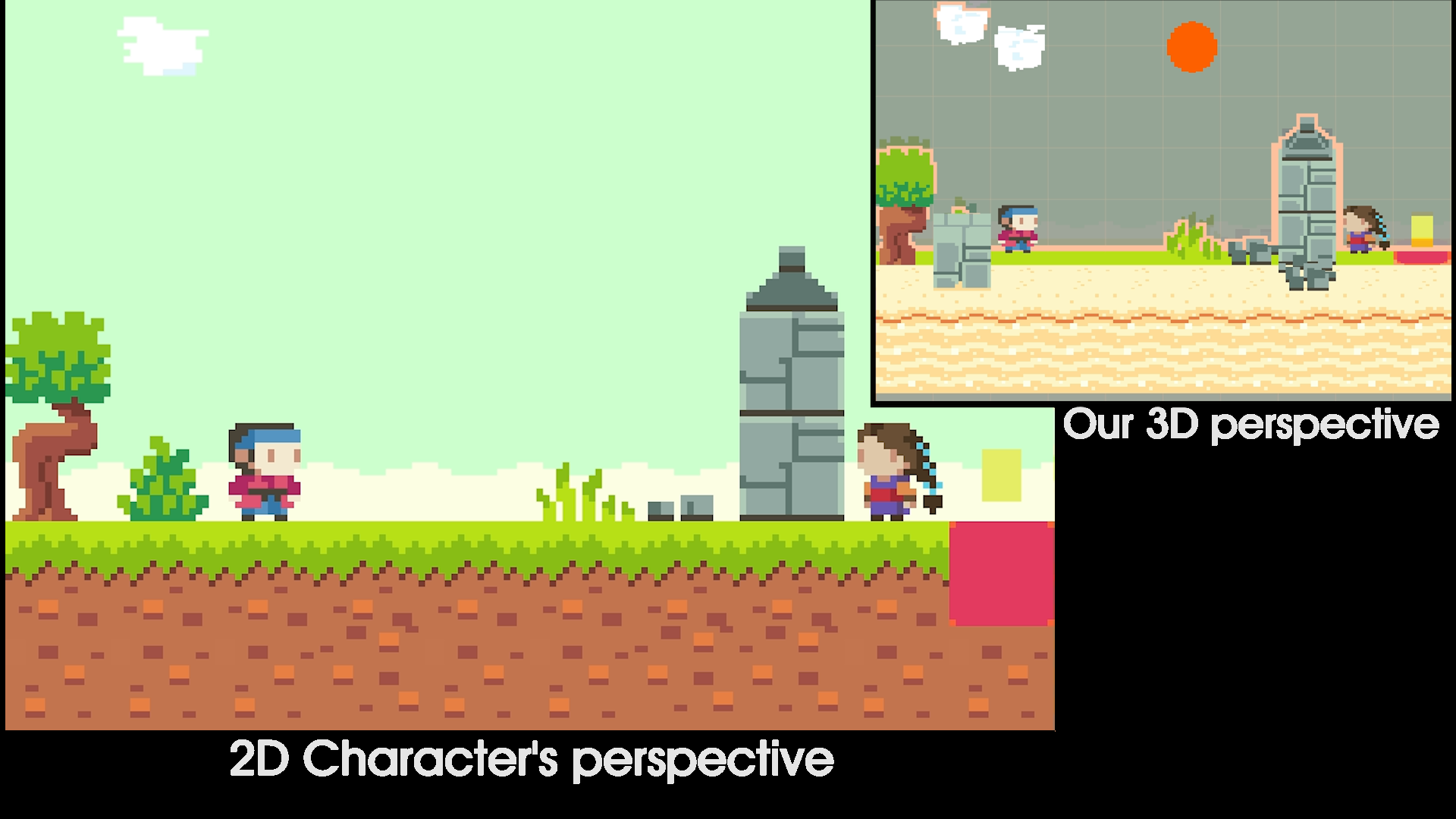When looking across worlds the windmill appeared strange, its swift blades moving in and out of sight. I could hear their faint echo ripple through the dry desert air.
There’s something very mysterious about a fourth spatial dimension. We can’t directly see or touch it. We don’t know if it exists, and if so in what form. It is difficult imagine, because our sensory system is built for three dimensions. Furthermore, most people have never tried imagining it at all.
And yet Miegakure can be understood and played by any random puzzle-game player, at PAX for example. How come?
[I messed] about with this strange toy until I quickly understood most of the problems that I faced. – Jim Rossignol (Rock Paper Shotgun)
When I did finally get it, I realized how fantastic Miegakure could be. –Tyler Wilde (PC Gamer)
It’s amazing how fluid the transitions between dimensions are, and how much sense it makes once you play. –Chloi Rad (IGN)
For me the main reason might be the fact that Miegakure starts by purposefully framing the fourth dimension from a particular point of view, one that we are very familiar with, that of parallel universes.
Think of a stack of paper, each piece of paper is a 2D square, but together they form a 3D cube. Each piece of paper is literally parallel to the other pieces of paper; they don’t intersect. The same thing happens in lower dimensions: we can build a 2D square out of parallel (1D) line segments, or a line out of (0D) dots. This pattern works in any number of dimensions: we can think of a 4D cube as being a stack of parallel 3D cubes. They are stacked along the fourth dimension.
So a 3D world can be seen as a stack of 2D spaces, as is shown in the trailer:
Similarly, the fourth dimension can be seen as literally parallel universes (A 4D world can be seen as a stack of 3D spaces). The fourth dimension is a way to mathematically define parallel universes in a rigorous way.

As a culture, we have been thinking about parallel worlds for a long time. Here’s a long list of Parallel Universes in Fiction on Wikipedia, going back to Through the Looking-Glass and The Lion, the Witch and the Wardrobe.
Some parallel universes are completely separate from each other, but some are connected in some way. In games there’s the Dark World and the Light World from Zelda A Link to the Past and A Link between worlds. There are also parallel worlds that are the same world but at different times, like Back to the Future, and Chrono Trigger.
Miegakure happily leverages all this experience we have thinking about parallel universes, but extends the concept as contained in the concept of 4D space.
I find it a bit similar to skeuomorph interfaces used previously on the iPhone, where for example the calculator looked like an actual old calculator. “it makes it easier for those familiar with the original device to use the digital emulation by making certain affordances stronger.” [Wikipedia] We can recreate something that people are familiar with, but also extend it, freed from the physical limitations.
In Miegakure, especially at the beginning of the game, to help players understand the game we texture the ground differently at intervals, to group parallel worlds together and visually differentiate them. So the first main thing that needs to be figured out when playing Miegakure is how do the literally parallel worlds (that are a natural consequence of a 4D world) manifest themselves in the game. How do you move between them? How do they relate to each other? Which point in one world is closest to this other point in another?
While any interaction with a video-game is very instinctive (especially at first, and since I chose to make the game teach non-verbally), at a basic level these questions do have relatively simple answers that can be expressed in words, in part because of the vocabulary we have built for parallel universes.

Of course, A 4D world is more than an stack of independent 3D worlds, just like a 3D world is more than an stack of independent 2D worlds.. Something deeper is going on, something that takes longer to grasp. Something that players tend to feel but can’t express in words.
For example, while these worlds are parallel, they are not necessarily independent. So while each piece of paper in our stack can contain its own 2D world, independent of all the other worlds, this stack is different from a cube, which is a single continuous object. If we still insist on seeing the 3D object from a multiple-2D-worlds perspective, we can say that the worlds can somehow be connected/attached to each other. They can also rotate together by rotating the whole thing, etc…
Furthermore, a true 3D object might look very complicated and confusing if we only saw it through 2D slices. And so similarly if you look at the shape at the beginning of the 2nd trailer or the end of the first, you can see that it is not made out of layers (parallel worlds). It is a 4D shape called the 120-cell.
My design goal in creating Miegakure is to use the very familiar concept of parallel worlds as a strong foundation for understanding, acknowledging it as a part of the concept of a fourth dimension, but to not limit the game to it. Since the game is properly programmed in 4D if players wish to dig deeper there are plenty of things to discover and try to understand, things that I sometimes don’t even fully understand myself.







As always sounds awesome. Congrads on ps4 release. Steam? When?
Steam yes. When it’s done.
How long o you think it will take till it is out on steam? Also, will there ever be a mobile version of this game? (would it even work as a mobile game?) What would a 5D version be like and would you ever consider trying to make a 5D game? Have I asked too many questions?
There might be a mobile version, with some adjustments needed.
When this game is done, I will be happy to buy it.
Just wondering, will you be hiding any easter eggs or other secrets in the game?
Yes.
Will you be hiding a Oculus(for 3d, not VR)/3D(viewing) mode in the game? Or making it obvious?
Maybe.
I might buy a VR headset just for this game if it supported VR
Man
When you will lunch this game
Is there any demo released
Can I bay it some where
I’m tracking your activity the last four years 🙂
Hiya MtB! If you don’t mind giving us one other peek behind the scenes, what would be really amazing to see are some of the fully 4D views of a few objects/places in the game that you get from your dev tools. I am assuming you aren’t modeling things in 3D slices but have some sort of 4D-to-3D projector/viewer that allows you to rotate the models arbitrarily? If so, how cool do these levels look when *not* cut away to a 3D hyperplane?
Or do you work on this in layers the way they are presented in the game? (In which case, wow, that would be impressive, e.g. to glue together the textures on that 120-cell seamlessly when viewing only a 3D slice at a time…)
Neither! The 120-cell and other 4D objects are built/textured procedurally.
Ah, well then maybe as an easter egg you could offer a mode/shader that projects the xyz axes onto the xy plane (e.g. isometrically, at 60 deg, or something), and the w axis simply becomes the z axis, and thus display the whole 4D set of parallel worlds in 3D. Like a debug/god mode.
It’d be confusing as hell but fascinating!
Hum, there may be a game mechanic that is close to what you are talking about 🙂
I like the sound of that 😀
I agree that it seems as if people very often have some intuition of how 4D works, especially since there is good evidence by how well people picked up the underlying principles when playing the demo of Miegakure.
But I don’t think it’s just because of experience with parallel dimensions in fiction, but rather our every day notion of time. Even though time is not a spatial dimension, it does act as a fourth dimension to our sense of 3D. I think people are good at visualizing in 4D with a little practice, because we already think in 4D to some extent whenever we have to imagine a timeline, a sequence of events, and even time travel in fiction.
Time to me is a string of timeless worlds.
That is a good point! In a typical story about time-travel (such as Back to the Future for example), if feels as if each moment in time has its own timeline, and that is very similar to 4D space.
I still trying to think in 4 dimensions. Awsome xD
It’s quite amazing to see all the objects change in the 4th dimension, I love it. Really makes me wonder how it’s all made. Keep up the work man, it’s well worth the effort.
As someone who likes String Theory’s take on the universe, (I’m betting on either String Theory or The Standard Model) this game will be in my Steam Library faster than a photon that’s bending spacetime.
Every update gets me more and more excited about the Steam release! Very excited to get to savor the art and detail first-hand.
ive been following this for a long time. Just wanted to let you know that I’m more excited than ever to play the game when it comes out. I’m glad you’re taking the time to bring to life such a great idea. Hopefully you can work out a way to get this game in school computer labs. If I were a math teacher I would make every student play a game like this.
Will there be player made levels that could be added, or you think only a small minority of players will bother to make levels as aesthetically pleasing?
The level format is open source and I might do a proper level editor some day after realease.
😀 😀
I cannot this wait to play this!
I have been wondering about how the characters 4d-shape is. Do they have a constant width? Is that zero? Or do they have some other shape.
The way NPCs appear just by standing in the right section upon rotating the camera, suggests to me that they have the same width as the tetrahedra, but since the player doesn’t constantly collide with invisible objects, he seems to be flat. How is it really?
They have a little bit of 4D width but they also get rotated/projected a bit so you see them more than you normally would. Not too happy about that but it helps gameplay a lot.
The player has a tiny amount of 4D width.
I have a question. So, since this game is presented in 3-D, but there are four total dimensions in the game, that means that whenever you choose to move along the “w” axis, you must abandon one of the original three dimensions to do so. Would you always abandon the same one, or would it be a choice? I’m assuming the the “y” dimension (vertical) would be constant since the ground is always the ground, but what about “x” and “z”? This seems to be the case in the GIF with the 4-D shape, but I want to be sure. Otherwise, this seems like it will be an amazing game, and I can’t wait to play it!
You always abandon the same one, one of the horizontal dimensions. I talk about it more here: http://marctenbosch.com/news/2014/10/nature-as-designer-there-was-only-one-way-to-design-miegakure/
I have a question, what will happen when a guy tries to … plane shift into a wall?
And what will these new directions be called?
The mechanic is not shifting but rotating the plane. So that can’t happen.
Ana and Kata I guess?
You wouldn’t be able to. Plane-shifting into a 3d wall in the 4th dimension is basically just like trying to walk into a 2d wall in the 3rd dimension.
So in this 4D world of Miegakure, human beings are still 3D objects?
Exist there any true 4D object in this world? Something that extends in every parallel 3D world?
Human are 3D with a small 4D thickness. Yes, there are true 4D objects, like this.
Just wanted to know, do you think that there might be a mobile version? It could be made simpler if you needed it to be.
This game is amazing but its tremendous potential. By making real a 4D world, possibilities are endless. I can already see a game that will offer a procedural generated universe (like no man’s sky) but in 4D, or 5D or even nD. That will be extraordinary and awesome.
I hope Miegakure will opens up people’s mind about 4D world, so that concept will be common in the future.
Awesome job and congratulations !
This game makes monument valley look simple and normal.
I am extremely interested in the method you use to maintain the smoothness when procedurally rendering the shift along the W “face” as it seems that there would be much more noise and distortion. It feels as if you are maintaining some sort of geometric rigidity in the videos that you have shown because of the harsh bell-curve type distortion that is actually represented. As a 3D metaphor, the corner of a cube being traversed by a rolling sphere, I suppose.
I could be wrong, but it seems like you would need a far better method of easement between slices than simply lerping it.
Also, it feels as if you have limited the Z (in this case, height) to prevent even more distortion! And it seems that it still is difficult to redefine the slice in any way that does not leave floating segments.
Would you be interested in sharing your general methods at some point? Perhaps after the game is complete?
How is the game doing? I am waiting to spend my money. 🙂
Good!